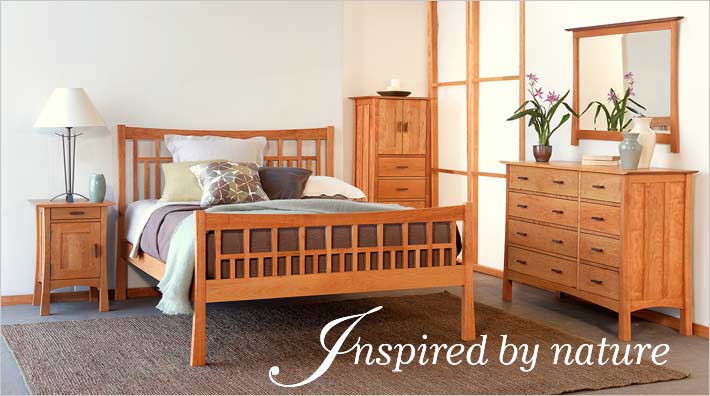The results? A timeless and eco-conscious interior that is grounded in nature and brimming with health and wellness benefits.
Characteristics of Biophilic Design
 Notice how our solid wood Modern Shaker Filing Cabinet fits into this biophilic office design with natural sunlight, potted plants, and hardwood floors.
Notice how our solid wood Modern Shaker Filing Cabinet fits into this biophilic office design with natural sunlight, potted plants, and hardwood floors.Biophilic design is a nature-inspired style that incorporates natural elements like plants, wood, stone, water, and more. Here are a few key characteristics that help define this style:
- Natural: Favors wood and other materials found in nature over man-made materials
- Sustainable: Uses sustainable materials that do no harm to users or the environment
- Earthy: Uses colors found in nature, such as brown, green, cream, and tan
- Illuminated: Heavy on natural light or light that mimics the sun’s natural color cycle and our circadian rhythm
- Innovative: Will often leverage the natural landscape—instead of destroying it—for new builds.
- Green: Incorporates indoor plants for air filtering and aesthetic purposes
- Immersive: Captivates the senses through not just sights, but also sounds, smells, and even tastes found in nature.
- Connected: Bridges man-made structures with nature using atriums, porches, decks, and large windows
History of Biophilic Design
Biophilic design has only been around for about 20 years, but many elements of this branch of design can be found in the early 20th century in the form of organic design and Scandinavian design. Or, even more impressively, as far back as approximately 600 BC in the architecture of the Hanging Gardens of Babylon.
“Nature holds the key to our aesthetic, intellectual, cognitive and even spiritual satisfaction.” -E. O. Wilson
It was the biologist Edward O. Wilson who coined the term biophilia in his book of the same name, Biophilia (1984). Eventually, this concept of subconsciously seeking a connection with nature would be introduced to the world of design through a framework created by Stephen Kellert. This framework would provide guidelines for incorporating nature into the built environment using both direct (natural and tangible features, such as natural light, plants, and water) and indirect biophilia (features merely representational of nature, such as nature illustrations, natural materials, organic shapes).
The best examples of biophilic design will use both indirect and direct biophilia to create a potent effect with an array of health and wellness benefits.
Benefits of Biophilic Design
 Plants, natural light, and paintings of nature help this artist be happier and more creative.
Plants, natural light, and paintings of nature help this artist be happier and more creative.It is important to note that biophilic design is more than just a potent aesthetic, it is a method of design that can improve both the users’ health and wellness, as well as the environment. Being a relatively new concept on the interior design scene, there are still many benefits of this design principle to be explored, but here are a few key tidbits we already know:
- Healthier Air: Plants improve indoor air quality by filtering out harmful chemicals— like formaldehyde, benzene, and trichloroethylene—that commonly off-gas from building material and furniture. (NASA Clean Air Study, 1989)
- Faster Healing: Patients with a view of nature required less pain medication and had faster recovery times. (Dr. Roger Ulrich, 1993)
- Reduced Stress: Aromatherapy, such as nature scented essential oils, can improve sleep in 95% of cases. (Aromatherapy Meta-analysis, 2015)
- Environmentally Friendly: Biophilic design harnesses the power of nature, while also aiming to do no harm. This means that it is mindful of materials and practices used during both building and decorating interiors, essentially helping to preserve the environment.
Three Ways to Incorporate Biophilic Design into Your Home
1. Choose Natural Materials
 Notice all the natural materials in this photo- cherry wood rocking chair and end table, red oak flooring, birch firewood, the straw basket, and other natural accents.
Notice all the natural materials in this photo- cherry wood rocking chair and end table, red oak flooring, birch firewood, the straw basket, and other natural accents.Wood, ceramic, and organic textiles are commonly used. Weaving an array of materials throughout biophilic interiors is an excellent way to create visual interest, but one material that should always be avoided is plastic.
Look for furniture that uses materials that are both sustainably sourced and healthy. Often minimally finished wood furniture or reclaimed wood products are an easy choice with their naturally earthy aesthetic, imperfections, and timelessness.
2. Go Big on Plants
 Notice how the plants, natural sunlight, and wood grain contribute to the overall design of of this bedroom. Shown here our Larssen Chest in solid, natural walnut.
Notice how the plants, natural sunlight, and wood grain contribute to the overall design of of this bedroom. Shown here our Larssen Chest in solid, natural walnut.Incorporating plants into an interior is an easy way to add direct biophilia on any budget. Not only are many varieties visually stunning, but they can also help filter harmful chemicals out of the air.
Place a few potted plants around your home. Snake plants, English ivy, or Chinese evergreens are all great at filtering the air. Have pets? Make sure to go for varieties that are safe if they decide to have a nibble. Boston ferns, bamboo palms, and spider plants are all excellent choices.
3. Indulge Your Senses
 Notice here the indirect biophilic design influence of the bunny-painted ceramics, and imagine how the scent of fresh peaches and flowers could contribute to the general ambiance of a dining room like this one.
Notice here the indirect biophilic design influence of the bunny-painted ceramics, and imagine how the scent of fresh peaches and flowers could contribute to the general ambiance of a dining room like this one.Everyone wants their home to look good, but don’t forget that it should also feel good. By tending to senses beyond sight, specifically smell and hearing, you can instantly enhance a space.
Create an aromatherapy corner in your bedroom by using a fragrant plant or a diffuser with lavender, pine, cedar or other nature scented oils (Again, please be mindful if you have pets though as some essential oils can be harmful). For sound, listen to a playlist that features the sounds of nature. You can often find these on YouTube for free or available as CDs.
Whether you are looking to add some more nature to a shabby chic space, want to embrace Kinfolk living, or just want to be more mindful of your interior design practices, biophilic design is the perfect place to turn. With its sustainability and focus on health and wellness it isn’t just a passing trend— it is the design principle of the future.


